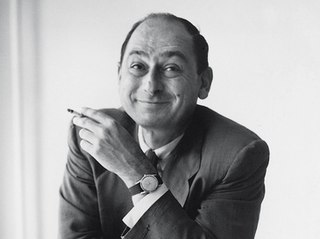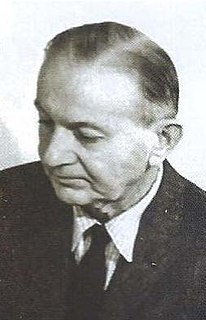
The Aeron chair is an office chair sold by Herman Miller, first released in 1994. In 2010, it was called "America's best-selling chair". It is featured in the Museum of Modern Art's permanent collection. It was designed by Don Chadwick and Bill Stumpf and has received numerous accolades for its industrial design.

A cubicle is a partially enclosed office workspace that is separated from neighboring workspaces by partitions that are usually 5–6 feet (1.5–1.8 m) tall. Its purpose is to isolate office workers and managers from the sights and noises of an open workspace so that they may concentrate with fewer distractions. Cubicles are composed of modular elements such as walls, work surfaces, overhead bins, drawers, and shelving, which can be configured depending on the user's needs. Installation is generally performed by trained personnel, although some cubicles allow configuration changes to be performed by users without specific training.

George Nelson (1908–1986) was an American industrial designer. While lead designer for the Herman Miller furniture company, Nelson and his design studio, George Nelson Associates, designed 20th-century modernist furniture. He is considered a founder of American modernist design.

The Eames Lounge Chair and ottoman are furnishings made of molded plywood and leather, designed by Charles and Ray Eames for the Herman Miller furniture company. They are officially titled Eames Lounge (670) and Ottoman (671) and were released in 1956 after years of development by designers. It was the first chair that the Eameses designed for a high-end market. Examples of these furnishings are part of the permanent collection of New York's Museum of Modern Art.
William Eugene Stumpf was a designer for Herman Miller who helped design the Aeron, Embody and Ergon chairs.
Robert Propst (1921–2000) was an American inventor. He was the inventor of the Action Office that evolved into the cubicle office furniture system.
The Action Office is a series of furniture designed by Robert Propst, and manufactured and marketed by Herman Miller. First introduced in 1964 as the Action Office I product line, then superseded by the Action Office II series, it is an influential design in the history of "contract furniture". The Action Office II series introduced the concept of the flexible, semi-enclosed workspaces, now better known as the cubicle. All cubicle office designs can be traced back to Herman Miller's Action Office product lines.

Alexander Girard, affectionately known as Sandro, was an architect, interior designer, furniture designer, industrial designer, and a textile designer.

Knoll, Inc., is an American design firm that produces office systems, seating, files and storage, tables and desks, textiles (KnollTextiles), and accessories for the office, home, and higher education settings. The company manufactures furniture for the home by Ludwig Mies van der Rohe, Harry Bertoia, Florence Knoll, Frank Gehry, Charles Gwathmey, Maya Lin and Eero Saarinen under the company's KnollStudio division. Over 40 Knoll designs can be found in the permanent design collection of The Museum of Modern Art in New York City.

The Eames Lounge Chair Wood (LCW) is a low seated easy chair designed by husband and wife team Charles and Ray Eames.

Ray-Bernice Alexandra Kaiser Eames was an American artist and designer who worked in a variety of media.

Charles Ormond Eames, Jr. (1907–1978) and Bernice Alexandra "Ray" Kaiser Eames (1912–1988) were an American married couple of industrial designers who made significant historical contributions to the development of modern architecture and furniture through the work of the Eames Office. They also worked in the fields of industrial and graphic design, fine art, and film. Charles was the public face of the Eames Office, but Ray and Charles worked together as creative partners and employed a diverse creative staff. Among their most recognized designs is the Eames Lounge Chair and the Eames Dining Chair.
Donald "Don" T. Chadwick is an American industrial designer specializing in office seating.
Gilbert Rohde (1894–1944), whose career as a furniture and industrial designer helped to define American modernism during its first phase from the late 1920s to World War II, is best known today for inaugurating modern design at Herman Miller Inc.
The Eames Aluminum Group series is a line of furniture designed by Charles and Ray Eames. While the furniture, particularly the task chair, is an icon of office furniture, it was originally commissioned as outdoor seating for the home of J. Irwin Miller by Eero Saarinen and Alexander Girard. The original design featured a woven suspension back and seat stretched between aluminum ribs.

Marshmallow Love Seat #5670, commonly known as the Marshmallow sofa, is a modernist sofa produced by the American furniture company Herman Miller, that was originally manufactured between 1956 and 1961. It is considered the most iconic of all modernist sofas. The sofa was designed by Irving Harper of George Nelson Associates. It was produced in two lengths from 1956 to 1961. It consists of a metal frame with round discs of covered foam, or "marshmallows", spread across the seat and back in a lattice arrangement.
Irving Harper was an American industrial designer. While working for George Nelson Associates, Inc. on designs for Herman Miller furniture, Harper became one of the most prolific designers of the modernist style. Among his important designs is the Herman Miller company logo, and the company's Marshmallow sofa.
Don Charles Albinson was an American industrial designer who made many contributions to the world of furniture. He worked with Charles and Ray Eames for 13 years, helping develop many of the seminal Herman Miller furniture pieces from the mid century – the bent plywood chair, the fiberglass shell chair, the aluminum group set, and the Eames Lounge chair, to name a few. He later developed the Knoll Stack chair, the Westinghouse office line, an update to the DoMore Series 7 landscape system named Neo 7, the Albi stack chair for Fixtures, and the Bounce chair for Stylex.
Hume Modern is an American furniture restoration specialist. It is known for preserving items by Charles and Ray Eames, Florence Knoll, Eero Saarinen and other manufacturers of the American and European mid-century modern period. The company received plaudits in the wake of Hurricane Sandy for restoring items damaged by the New York/New Jersey seaboard. Hume Modern also restores pieces by Harry Bertoia, Warren Platner, George Nelson, Richard Schultz, Marcel Breuer, Frank Gehry, Mies van der Rohe and Herman Miller.

The Eames Molded Plastic & Fiberglass Armchair is a fiberglass chair, designed by Charles and Ray Eames, that appeared on the market in 1950. The chair was intentionally designed for the ‘International Competition for Low-Cost Furniture Design.’ This competition, sponsored by the Museum of Modern Art, was motivated by the urgent need in the post-war period for low-cost housing and furnishing designs adaptable to small housing units.













